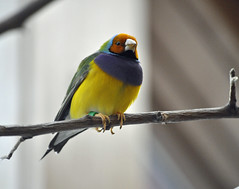A Gouldian Book Review
This post has a couple of purposes.
A) The first is to investigate the Blogger application (I loathe the term ' app' with a great passion) on Frances' iPad. Does it come close to the Windows version of Blogger?
B) Secondly, it is to offer some comments on the book "The business of nature: John Gould and Australia" by Roslyn Russell.
A first comment (about point A) is that I can't work out how to add hyperlinks, so they will come later. This becomes more important when I wish to refer to sources such as Ian Fraser and Jeannie Gray's book on bird names.
The book was lent to me by a friend who rated it highly. I am unsure if this score was because of the text describing John Gould's life and work or the collection of images which form the second half of the book. It doesn't really matter, since both are very good.
In the past it seemed that some scientists (or indeed academics generally) were able to waft around above the grubby clouds of economics. This book makes it clear that once he had a few 'runs on the board' to establish his reputation Gould was not a wafter. He defined what he was going to do, got subscriptions to finance it, and did it. Well done that boy!
I also found out some interesting snippets. For example:
- The Gouldian Finch was named by John, but to honour the memory of his late wife Elizabeth, who had prepared much of the lithography for his work;
- Many of the other images were by Edward Lear of 'nonsense rhymes' fame.
(Note that I can't do a bulleted list on the iPad so that formatting came later!)
The images are great- to state the bleedin' obvious! However the names associated with the images do demonstrate Gould's habit of using the (Latin) genus name with an Anglo addition as the vernacular name. For example: "Black-backed Porphyrio" for Purple Swamphen (with a scientific name - now - of Porphyrio porphyrio). While as Ian and Jeannie note such names were "never going to catch the public imagination", there are some genera in which this has continued - notably Gerygone, which re-emerged after a brief life in the vernacular as 'fly-eater' and/or warbler.
Overall, I strongly commend the book as a very informative read and a most enjoyable set of images.
Overall, I strongly commend the book as a very informative read and a most enjoyable set of images.
So let me now try to publish this! That I managed to do, although the version you are now reading has had a reasonable edit on my PC. I do, however reckon that the iPad has a clear place in my armoury for off-line drafting, when the 'net isn't available.




Comments